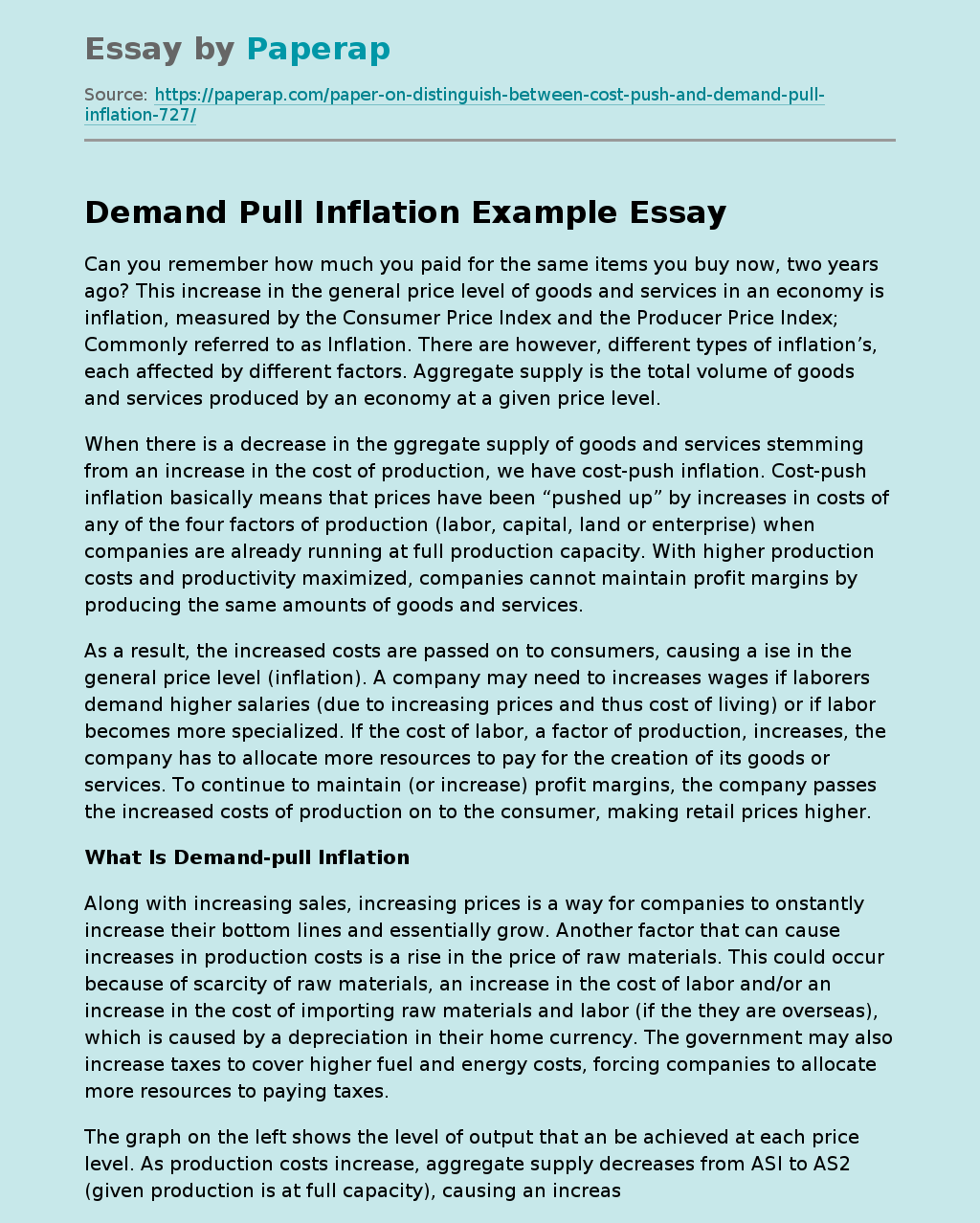Demand Pull Inflation Example
Can you remember how much you paid for the same items you buy now, two years ago? This increase in the general price level of goods and services in an economy is inflation, measured by the Consumer Price Index and the Producer Price Index; Commonly referred to as Inflation. There are however, different types of inflation’s, each affected by different factors. Aggregate supply is the total volume of goods and services produced by an economy at a given price level.
When there is a decrease in the ggregate supply of goods and services stemming from an increase in the cost of production, we have cost-push inflation. Cost-push inflation basically means that prices have been “pushed up” by increases in costs of any of the four factors of production (labor, capital, land or enterprise) when companies are already running at full production capacity. With higher production costs and productivity maximized, companies cannot maintain profit margins by producing the same amounts of goods and services.
As a result, the increased costs are passed on to consumers, causing a ise in the general price level (inflation). A company may need to increases wages if laborers demand higher salaries (due to increasing prices and thus cost of living) or if labor becomes more specialized. If the cost of labor, a factor of production, increases, the company has to allocate more resources to pay for the creation of its goods or services. To continue to maintain (or increase) profit margins, the company passes the increased costs of production on to the consumer, making retail prices higher.
Along with increasing sales, increasing prices is a way for companies to onstantly increase their bottom lines and essentially grow. Another factor that can cause increases in production costs is a rise in the price of raw materials. This could occur because of scarcity of raw materials, an increase in the cost of labor and/or an increase in the cost of importing raw materials and labor (if the they are overseas), which is caused by a depreciation in their home currency. The government may also increase taxes to cover higher fuel and energy costs, forcing companies to allocate more resources to paying taxes.
The graph on the left shows the level of output that an be achieved at each price level. As production costs increase, aggregate supply decreases from ASI to AS2 (given production is at full capacity), causing an increase in the price level from Pl to P2. The motivation behind this increase is that, for companies to maintain (or increase) profit margins, they will need to raise the retail price paid by consumers, thereby causing inflation. Demand Pull Inflation, however, occurs when there is an increase in aggregate demand, categorized by the four sections of the macro economy: households, usinesses, governments and foreign buyers.
When these four sectors simultaneously want to purchase more output than the economy can produce, they compete to purchase limited amounts of goods and services. Buyers, in essence, “bid prices up”, again, causing inflation. This excessive demand, also referred to as “too increase in aggregate demand that causes demand-pull inflation can be the result of various economic dynamics. For example, an increase in government purchases can increase aggregate demand, thus pulling up prices.
Another factor can be the epreciation of local exchange rates, which raises the price of imports and, for foreigners, reduces the price of exports. As a result, the purchasing of imports decreases while the buying of exports by foreigners increases, thereby raising the overall level of aggregate demand (we are assuming aggregate supply cannot keep up with aggregate demand as a result of full employment in the economy). Rapid overseas growth can also ignite an increase in demand as more exports are consumed by foreigners. Finally, if government reduces taxes, households are left ith more disposable income in their pockets.
This in turn leads to increased consumer spending, thus increasing aggregate demand and eventually causing demand-pull inflation. The results of reduced taxes can lead also to growing consumer confidence in the local economy, which further increases aggregate demand. When aggregate demand increases without a change in aggregate supply, the ‘quantity supplied’ will increase. If aggregate demand increases from ADI to AD2, in the short run, this will not shift aggregate supply, but cause a change in the uantity supplied as represented by a movement along the AS curve.
The reasoning behind this lack of shift in aggregate supply is that aggregate demand tends to react faster to changes in economic conditions than aggregate supply. As companies increase production due to increased demand, the cost to produce each additional output increases, as represented by the change from Pl to P2. This is because companies would need to pay workers more money (e. g. overtime) and/or invest in additional equipment to keep up with demand, thereby increasing the cost of production.
Demand Pull Inflation Example. (2019, Dec 05). Retrieved from https://paperap.com/paper-on-distinguish-between-cost-push-and-demand-pull-inflation-727/

